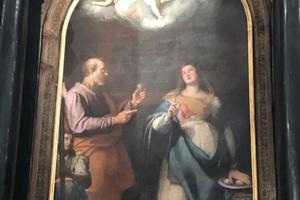St. Agatha, Tormented and Imprisoned for the Lord
Hatred for the Church and hatred for its sexual morality have often gone hand-in-hand, as we see in the Decian Persecution and the life of St. Agatha.

St. Agatha is another of those seven women, virgin martyrs, named in the First Eucharistic Prayer (Roman Canon). Since they’re often mentioned at Mass, it’s worth knowing more about them. We already met St. Lucy and St. Agnes.
Agatha predated Lucy and Agnes by about 50 years. She lived from about A.D. 231 to 251. Indeed, it was Lucy’s and her mother’s visit to the tomb of St. Agatha that confirmed Lucy in her own vocation as a virgin, a visit depicted in the work of Jacobello del Fiore, on which we commented.
Like Lucy, Agatha came from Sicily. Like Agnes and Lucy, Agatha had a suitor who would not take “no” for an answer.
Agatha’s suitor was Quintianus, a local Roman official. Her rejection of his proposals and her profession of faith in Christ caused Quintianus to denounce her.
These events took place at the time of one of the several more intense persecutions of Christians in the Roman Empire that erupted like spasms from time to time. Emperor Decius launched the persecution upon his ascent to the imperial throne in A.D. 249; it lapsed after about a year and a half when Decius died in 251.
Short-lived but intense, the Decian Persecution also claimed the life of the incumbent pope, St. Fabian, in 250. Ostensibly intended to bolster Roman unity and cohesion and rebuild a declining state, Decius decreed that all his subjects were bound to offer a sacrifice to the Roman gods and burn incense for the good of the emperor, documenting these acts in the presence of a Roman magistrate by the third century equivalent of an “incense passport,” a libellus. Those who refused or lacked documentation were deemed acting contrary to the common good and could be tortured, imprisoned or put to death, like Pope Fabian. There were no religious exemptions, except for Jews, in keeping with practices dating back to Julius Caesar that tolerated their monotheism.
Virginity was deemed a telltale sign of being associated with Christianity, so the denunciation of Agatha was credible. Like Agnes in the future, the Romans tried unsuccessfully to condemn Agatha to a brothel. She then underwent various forms of torture, including stretching on a rack-like instrument and the forced removal of her breasts by pincers. The injured Agatha was then imprisoned without food, drink or medical care, but tradition has it that St. Peter appeared to her to heal her breasts. She died in prison.
The Golden Legend account of Agatha’s passion is here.
Today’s art piece, “The Virgin Enthroned with Saints,” is from mid-1400s Sicily. Jesus and Mary occupy the center panels, but the four side panels feature Sts. John the Baptist and Paul and, on the upper half, the two Sicilian virgins: St. Lucy on the viewer’s left, St. Agatha on the right. Its creator is known as the “Master of the Transfiguration of Syracuse.” Sicily being a crossroads of East and West, both influences are found in this work.
Agatha is depicted with her usual attribute: a platter with her severed breasts (like Lucy is often shown with a plate of her gouged out eyes). She is often shown with blonde hair. Her crown and palm branch both point to her martyrdom. Sometimes — though not in this work — she is also depicted with her torturers’ instrument, the pincers used to remove her breasts. The domination of pink-red hues in this work’s depictions of Agatha and Lucy may also perhaps point to their martyrdoms.
For more information on St. Agatha in art, see here.
Hatred for the Church and hatred for its sexual morality have often gone hand-in-hand, as we see in the Decian Persecution and the life of St. Agatha. Her blood would inspire another young martyr, Lucy, some 50 years later.
Today’s artwork is found in the Bellomo Palace in Syracuse, Sicily.
- Keywords:
- virgins
- st. agatha















